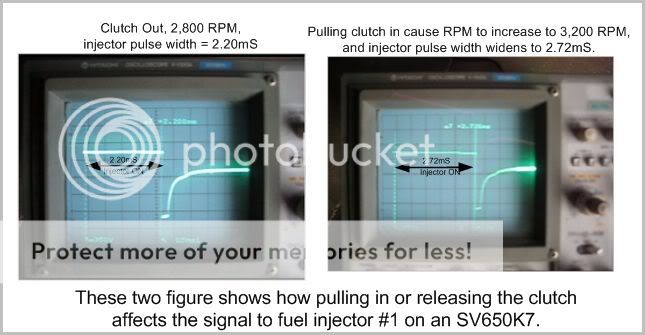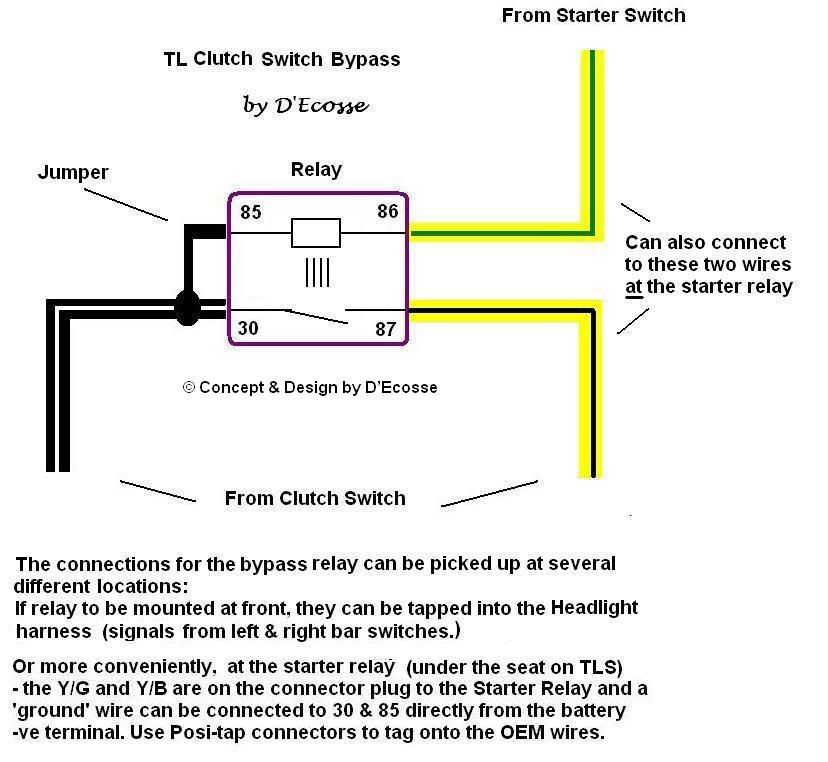As first (I believe) identified by SteveTLS,( http://wotid.com/tls/content/view/18/56/ ) the clutch switch provides more information than just an interlock for the starter.
It also provides an input to the ECM which selects different map (this was further validated by the guys hacking the ECM)
Actually Suzuki uses this feature on all its FI systems.
So it is important that you do not simply jumper out the wires to the clutch switch in order to bypass the clutch switch (so that lever does not have to be pulled in)
Shorting the switch permanently has negative consequences for 'normal' running - some are obvious and others may be more subtle.
For example on the SV650, it has a pronounced effect on gas mileage and you can see the effect of the switch on the injector pulse signal
(Image from TeeRiver published on SVRider)
![Image]()
On a GSXR it makes a significant different to the power output!
(Image from EDR Performance published on WERA forums)
![Image]()
Convinced? :devious
Bottom Line - not a good idea to just jumper out the switch!
Personally, I am not at all inconvenienced by it, but a lot of people seem to not want to have to pull in the lever. So here is safe work-around.
You have a couple of options:
1: You can jumper out the switch but cut the input at the ECM so that it does not see the 'permanent' clutch shorted condition
The downside is that the enhanced starting map will never be selected either.
2. Connect a relay across the switch.
This has the bonus of still temporarily selecting the appropriate enhanced starting map, while removing the requirement to actually pull in the lever.
Here is option 2:
![Image]()
As indicated, you can either connect this at the front/headlight harness, or directly at the starter relay itself. The wire colours are same at either location on both the TLS and TLR.
The signal starter button itself is what energizes the bypass relay.
Very simple mod to incorporate if you feel you really must have that bypass.
.
It also provides an input to the ECM which selects different map (this was further validated by the guys hacking the ECM)
Actually Suzuki uses this feature on all its FI systems.
So it is important that you do not simply jumper out the wires to the clutch switch in order to bypass the clutch switch (so that lever does not have to be pulled in)
Shorting the switch permanently has negative consequences for 'normal' running - some are obvious and others may be more subtle.
For example on the SV650, it has a pronounced effect on gas mileage and you can see the effect of the switch on the injector pulse signal
(Image from TeeRiver published on SVRider)

On a GSXR it makes a significant different to the power output!
(Image from EDR Performance published on WERA forums)
Convinced? :devious
Bottom Line - not a good idea to just jumper out the switch!
Personally, I am not at all inconvenienced by it, but a lot of people seem to not want to have to pull in the lever. So here is safe work-around.
You have a couple of options:
1: You can jumper out the switch but cut the input at the ECM so that it does not see the 'permanent' clutch shorted condition
The downside is that the enhanced starting map will never be selected either.
2. Connect a relay across the switch.
This has the bonus of still temporarily selecting the appropriate enhanced starting map, while removing the requirement to actually pull in the lever.
Here is option 2:

As indicated, you can either connect this at the front/headlight harness, or directly at the starter relay itself. The wire colours are same at either location on both the TLS and TLR.
The signal starter button itself is what energizes the bypass relay.
Very simple mod to incorporate if you feel you really must have that bypass.
.




